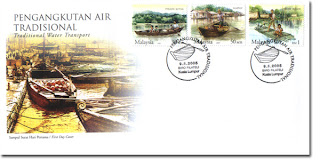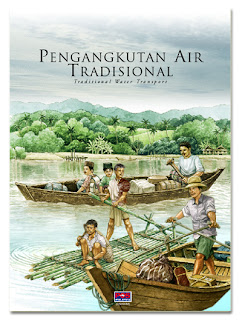 Traditional Water Transport
Traditional Water TransportThe first form of water transportation is the log. The rider sites on it with his legs used as oars. The rider also has the option of laying facedown
 with both his arms and legs used as oars. As time progressed, people advanced and had learnt to modify their oars by tying three or four pieces of wood together using fiber rope, rattan or ferns. The tied wood pieces form a flooring that floats on the water, and in turn becomes a RAKIT (raft). More modern water transportation such as carving out the center of a log into a SAMPAN is witnessed later on. The sampan is built in such a way that its entire frame consists of the ribs, the bow and the keel.
with both his arms and legs used as oars. As time progressed, people advanced and had learnt to modify their oars by tying three or four pieces of wood together using fiber rope, rattan or ferns. The tied wood pieces form a flooring that floats on the water, and in turn becomes a RAKIT (raft). More modern water transportation such as carving out the center of a log into a SAMPAN is witnessed later on. The sampan is built in such a way that its entire frame consists of the ribs, the bow and the keel.'Perahu Kotak' (Box Boat)
The box boat is built using pieces of planks. Its structure is simple as its frame is built without a bow, keel and 'papan lepang' and short 'rangka kun'. It is used by village folks as a vehicle for transportation in shallow, coastal waters of the river and to carry personal items.
Sampan
The entire sampan is made from pieces of plank,
 and exists in various sizes. A small sampan of approximately 2 to 3 meters long can accommodate 2 to 4 people. Most sampans are used on rivers as a form of transport. The sampan's belly is wide and its bow slopes steeply.
and exists in various sizes. A small sampan of approximately 2 to 3 meters long can accommodate 2 to 4 people. Most sampans are used on rivers as a form of transport. The sampan's belly is wide and its bow slopes steeply.'Rakit Buluh' (Bamboo Raft)
Bamboo rafts are the most common water transportation being used. They range from simple 1-man rafts to larger ones that serve different
 purposes. The larger rafts are made from 8-10 culms of bamboo measuring approximately 3 meters in length. Even larger ones are available too - these are 2-layered rafts amounting to 6-12 meters in length. These massive rafts are capable of transporting up to 6 persons and 450 kg of jungle produce. Some of these huge rafts may even contain a built-in temporary shelter, enabling passengers to get a good rest during long and taxing journeys.
purposes. The larger rafts are made from 8-10 culms of bamboo measuring approximately 3 meters in length. Even larger ones are available too - these are 2-layered rafts amounting to 6-12 meters in length. These massive rafts are capable of transporting up to 6 persons and 450 kg of jungle produce. Some of these huge rafts may even contain a built-in temporary shelter, enabling passengers to get a good rest during long and taxing journeys. 'Perahu Batang' (Long Boat)
'Perahu Batang' (Long Boat)The long boat is fashioned out of a log that is split lengthwise into two, and then carved into the shape of a boat. The inside surface is gouged out from the bow to the keel to make a sufficiently large hole to accommodate up to four or five boatmen. The long boat is used by riverside dwellers as a means of transportation to carry passengers and daily necessities.
 Technical Details
Technical DetailsDate of Issue : 9-Aug-2005
Stamp Value : 30 Sen; 50 Sen; RM 1.00
Stamp Size : 40mm X 30mm
Sheet Content : 20 Stamps
Miniature Sheet Denomination : RM2.00
Miniature Sheet Size : 100mm X 70mm
Stamp Size in Miniature Sheet : 40mm X 50mm
Perforation : 14
Paper : SPM Watermarked, Phosphor Coated
 Printing Process : Lithography
Printing Process : LithographyPrinter : Percetakan Keselamatan Nasional Sdn. Bhd.
Designer : Reign Associates Sdn. Bhd.
First Day Cover Value : 30 sen
Presentation Pack Value : RM 3.50
Miniature Sheet Value : RM 2.00
Folder Value : RM 5.00
|
|






0 comments:
Post a Comment